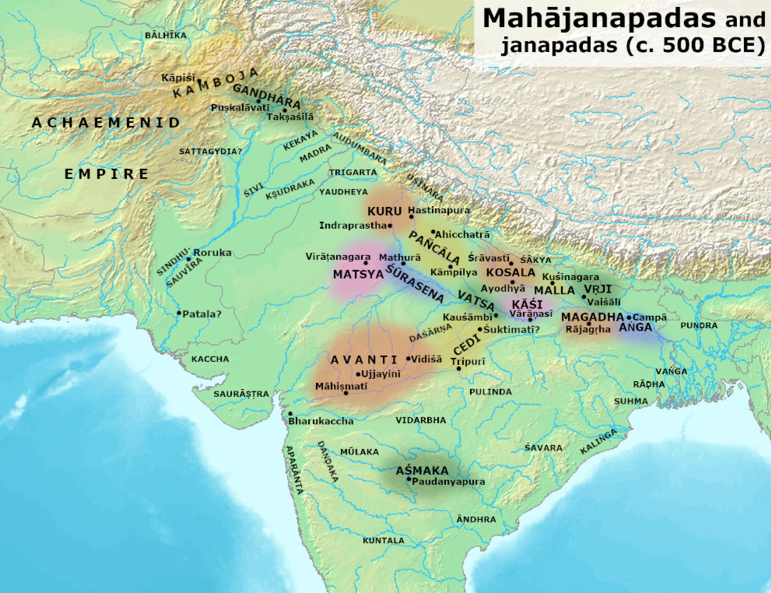Mahajanapadas were formed sixth century BC onward. The most prominent feature of Mahajanapadas is the formation of states. With the rise of Mahajanapadas, the political history of North India became clearer. 16 Mahajanapadas had both republics and monarchies and it is important to know about these for the IAS Exam. In this article, you will get to know the following:
- What are Mahajanapadas?
- What are 16 Mahajanapadas?
- Which was the most powerful Mahajanapada?
- What is the difference between Janapada and Mahajanapadas?
Aspirants preparing for GS 1 Ancient History can check similar articles from the links mentioned below:
| 100 Important Facts about Indus Valley Civilization (IVC) | Types of Vedas |
| Vedic Literature | Prehistoric India – Important Points |
What are Mahajanapadas?
Kingdoms that rose to fame from 6th Century BC onward were called Mahajanapdas. The Mahajanapadas signify the tribes that came together to form different groups and later gave rise to a permanent area of settlements called ‘states’ or ‘Janapadas.’
What are 16 Mahajanapadas?
The list below provides you with the names of 16 Mahajanapadas
- Kasi
- Kosala
- Anga
- Magadha
- Vajji
- Malla
- Chedi
- Vatsa
- Kuru
- Panchala
- Matsya
- Surasena
- Assaka
- Avanti
- Gandhara
- Kamboja
Candidates can refer to the 16 Mahajanapdas map to get an idea of their location. This can also help aspirants who have History subject as their optional in UPSC Mains Exam.

16 Mahajanapadas – Facts for UPSC Exam
Ancient India had several kingdoms in the 6th century BC. This era saw socio-economic growth along with religious and political developments crossways the Indo-Gangetic plain.
These settlements led the growth from Janapadas to Mahajanpadas. By 6th BC, the focus of chief political activity moved from the western part of Gangetic plain to the eastern part. The eastern part of Gangetic plain consists of present-day Bihar and eastern Uttar Pradesh. The main reason for this shift was the fertile lands, better climate and topography condition bestowed with rainfall and rivers. In fact, it was the augmented use of iron tools and weapons that empowered small states to develop as a kingdom which is later known as Mahajanapadas.
The table gives you the details about 16 Mahajanapadas:
| 16 Mahajanapadas | Capital of 16 Mahajanapadas | Modern Location of 16 Mahajanapadas | Facts about 16 Mahajanapadas |
| Anga | Champa | Munger and Bhagalpur |
|
| Magadha | Girivraja| Rajagriha | Gaya and Patna |
|
| Kasi | Kasi | Banaras |
|
|
Vatsa
|
Kausambi | Allahabad |
|
| Kosala | Sravasti | Eastern Uttar Pradesh |
|
| Saurasena | Mathura | Western Uttar Pradesh |
|
| Panchala | Ahichchatra and Kampliya | Western Uttar Pradesh |
|
| Kuru | Indraprastha | Meerut and Southeastern Haryana |
|
| Matsya | Viratnagar | Jaipur |
|
| Chedi | Sothivati | Jaipur |
|
| Avanti | Ujjaini or Mahismati | Malwa and Madhya Pradesh |
|
| Gandhara | Taxila | Rawalpindi |
|
| Kamboja | Pooncha | Rajori and Hajra |
|
| Ashmaka or Assaka | Pratisthan/ Paithan | Bank of Godavari |
|
| Vajji | Vaishali | Bihar |
|
| Malla | Kusinara | Deoria and Uttar Pradesh |
|
Magadha – The Most Powerful Mahajanapada
Magadha faced competition from Avanti, Kosala, and Vatsa for supremacy, however, over the years (600-400 BC), Magadha gained sovereignty and became the most powerful Mahajanapada. To read in detail about the rise and growth of the Magadha Empire, candidates shall check the linked article.
What is the difference between Janapadas and Mahajanapadas?
‘Jana’ in both terms means people. These people denoted a tribe or an ethnic group or a tribal political organization. Indo-Aryans, as mentioned in the early Vedic texts, used to live in the semi-nomadic tribal states. This tribal-state organization called ‘Jana’ transformed into Janapadas towards the end of the Vedic period. Janapadas then meant, a foothold of a tribe. And when the Janapadas started growing, they transformed into Majahanapadas.
To read the main differences between the Janapada and Mahajanapadas, you can refer to the linked article.
Features of Mahajanapadas
There are seven features or main constituents of a Mahajanapada and they are listed below:
- The King
- The Minister
- The Country
- Fortified City
- Treasury
- Army, and
- Ally
16 Mahajanapadas – UPSC History Notes:- Download PDF Here
The mentioned details are relevant for UPSC 2023 and aspirants are advised to read them carefully.
Related Links:
| Indus Valley Civilization | Prehistoric India |
| Vedic Civilization | Buddha & His Teachings |
| Jainism | History of Ancient India – NCERT Notes |

Comments